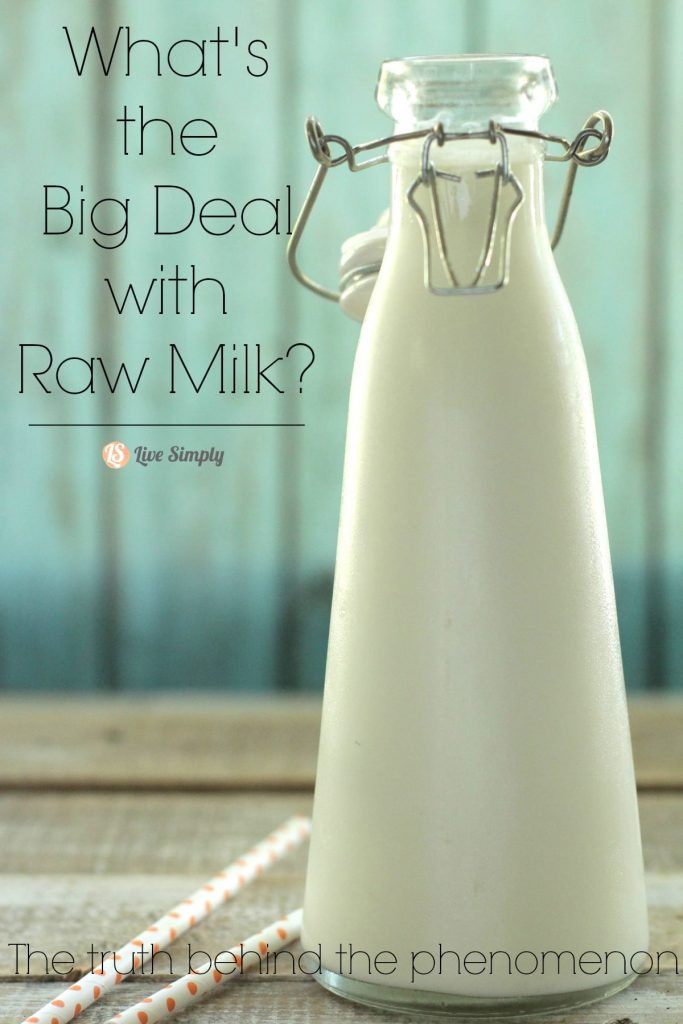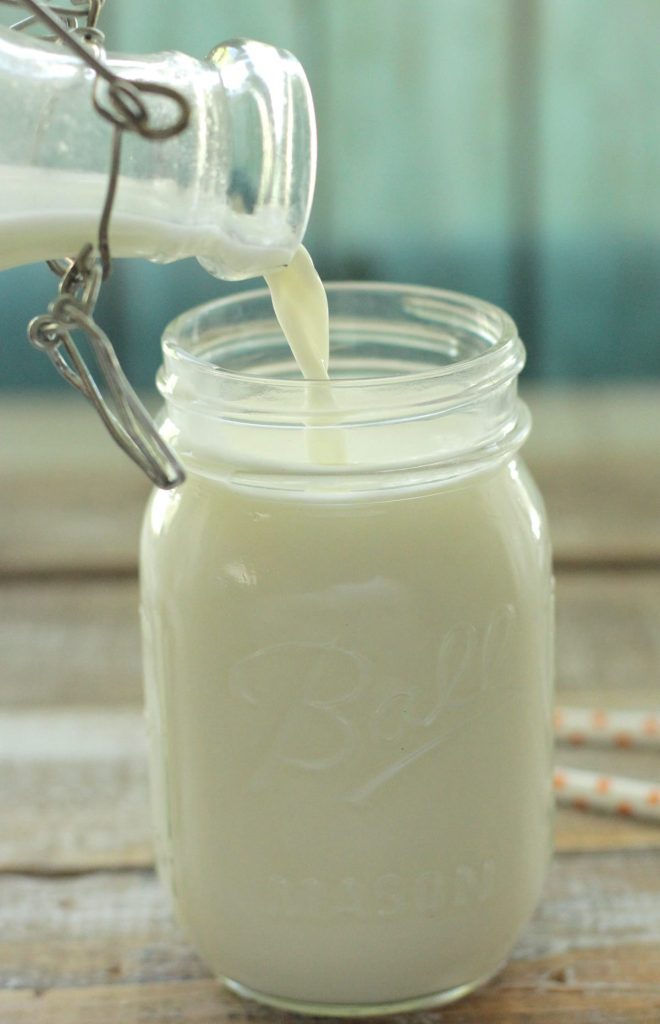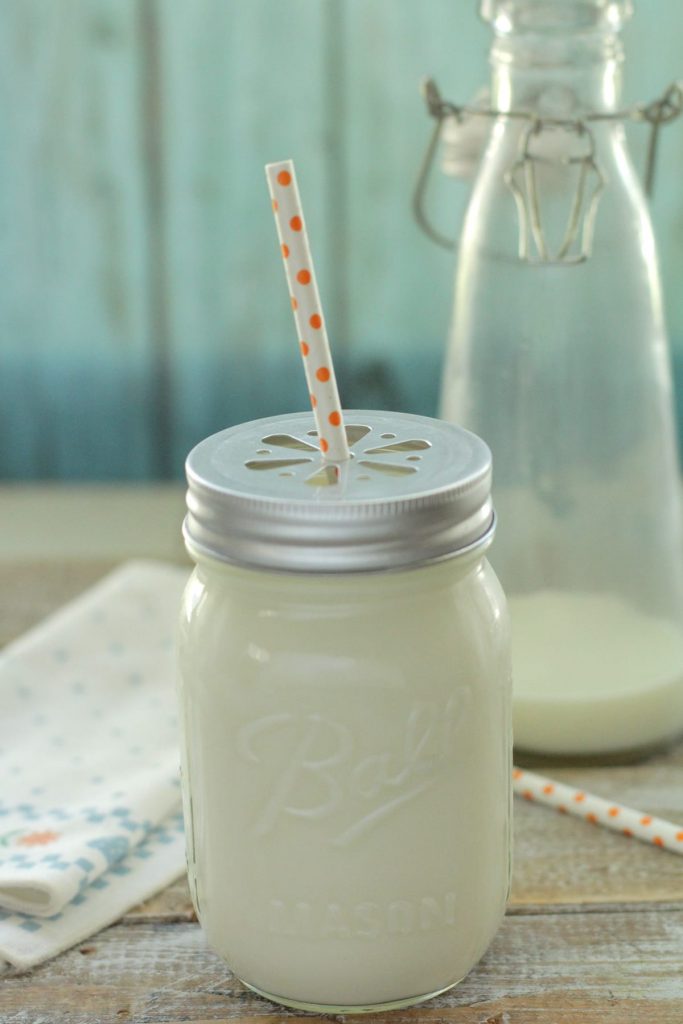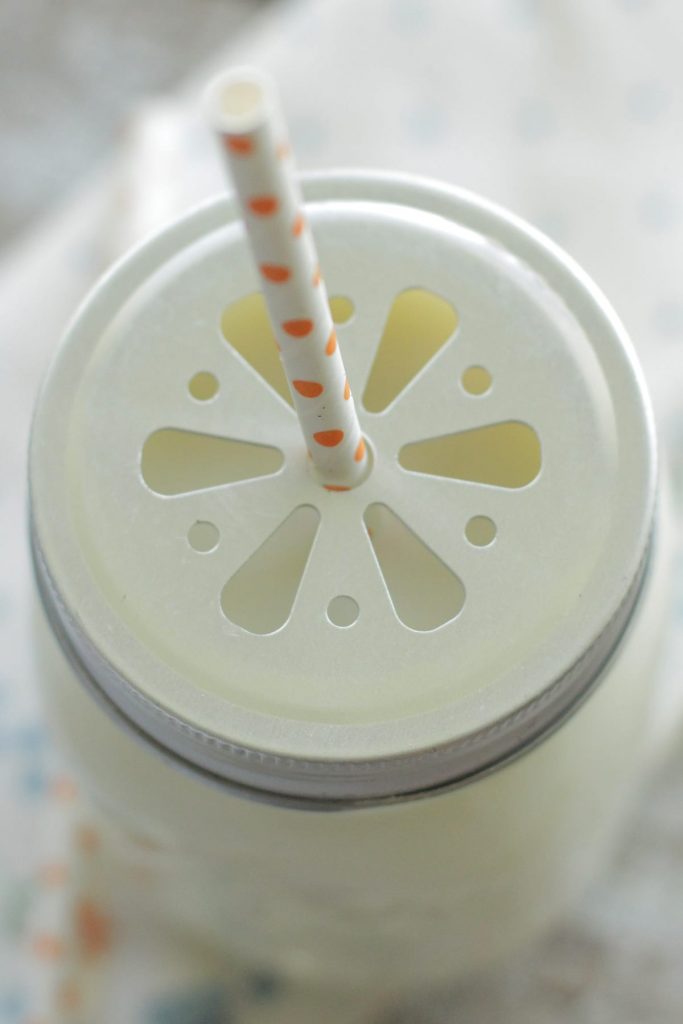There are a lot of milk choices out there today.
For the sake of clarification, I am talking about milk that comes from an animal. Alternative milks are a discussion for another day.
With so many choices there is a lot of confusion amongst consciousness moms and consumers like myself who want to provide their family with the best nutrition.
Today you can find:
- Conventional pasteurized homogenized milk.
- Organic pasteurized milk, non-homogenized (this is very hard to source).
- Organic pasteurized homogenized milk.
- Organic ultra-pasteurized homogenized milk.
And then there’s raw milk.
We are raw milk drinkers.It’s been a long progression from low-fat conventional milk to organic ultra-pasteurized whole milk to finally local farm fresh whole raw milk.
What is Raw Milk?
To put it simply, raw milk comes straight from the cow. You know, what the baby calves drink. It has not been heated to kill pathogens (simply those little organisms that can possibly cause disease). It’s not homogenized. Homogenization is:
a more recently invented process and it has been called “the worst thing that dairymen did to milk.” When milk is homogenized, it is pushed through a fine filter at pressures of 4,000 pounds per square inch. In this process, the fat globules are made smaller by a factor of ten times or more. Source
Raw milk is what generations before my grandparents drank. Milk in its pure unaltered state.
Alternatives to Raw Milk:
Most milk today is either pasteurized or ultra pasteurized.
Pasteurization: Pasteurization was invented by a man named Louis Pasteur in 1864. During this time, the Industrial Revolution, people began to move away from farms and country life embracing city life. Instead of milking cows from family farms people started relying more on milk from distributors and stores. As the need increased, profit flowed. Milk was driven by profit. Cows were taken off pastured grass, and were fed grains and cramped into pens. Traditional dairy breeds produced 3-4 gallons of milk a day, now were producing up to 4 times as much thanks to a “modern freak of nature” the Holstein cow. A cow that is selectively bred to produce abnormally active pituitary glands. This resulted in many problems.
Cramped conditions, overactive pituitary glands, and an abnormal diet brought about dirty milk filled with pus, sick cows needing frequent antibiotics due to sickness, and other health issues. Milk distributors also started to take short cuts in order to boost milk sales. It was during the 1800 reports began circulating of children dying due to dangerously-produced raw milk.
Instead of looking at the root of the problem and the fact that generations had consumed raw milk safely, in the 1930’s raw milk finally stopped being sold thanks to the big dairy producers pushing pasteurized milk. Instead of putting cows back on pasture in clean free roaming environments big business took the profit route. Cheap corn and grain, growth hormones to promote excessive milk production resulting in dirty milk, and cramped cow conditions all which produce harmful milk in need of pasteurization.
Pasteurization strips milk of helpful organisms, the good and the bad, leaving it unable to protect against undesired bacteria which can containment milk. Pasteurization also destroys the vitamins and minerals which make milk such a powerhouse of nutrients. Vitamins A and D are synthetically added back into pasteurized milk. The ultimate goal is the absence of enzymes which also destroys calcium and puts a large strain on the digestive system leaving many with problems digesting pasteurized milk. Check out this study to find out more on the digestive issues of pasteurized milk.
Ultra-pasteurization: This process takes milk and heats it to an extremely hot temperature (280º), killing literally everything. The results: dead milk! This milk literally retains nothing living and can not be cultured and processed into yogurt.
You may be buying what appears to be organic milk, however, you are getting nothing more than white liquid… an expensive white nutritionally-void, dead substance. In fact, chemicals can even be added into pasteurized (and ultra pasteurized) milk to help it retain the odor and taste of real fresh milk which is lost in the extreme heating. Yuck!
Why would companies, particularly, organic companies process the milk to such a dead state?
Simply because this process extends the shelf life of milk. When ultra pasteurization first came out, stores sold the boxed milk on the shelf as no refrigeration was needed for such a lifeless product. Consumers were hesitant of such milk, so today you will find most ultra pasteurized milk sold in the refrigerated section. This gives the appearance of fresh milk, however, it is much more of a marketing gimmick than necessity.
A giveaway milk is ultra pasteurized, is an expiration date lasting months from the purchase date. Since when did fresh milk last 6 months?
The Safety of Raw Milk:
First, for thousands of years people have been dependent on milk from cattle, sheep, goats, horses, water buffalo, or camels for protein and fat. Ask any great-great grandparent living today, and many will fondly share stories of drinking raw milk straight from the cow. Rawmilk.com shares a few of the safety features which are naturally built into raw milk.
Raw milk contains numerous components that assist in:
- Killing pathogens in the milk (lactoperoxidase, lactoferrin, leukocytes, macrophages, neutrophils, antibodies, medium chain fatty acids, lysozyme, B12 binding protein, bifidus factor, beneficial bacteria);
- Preventing pathogen absorption across the intestinal wall (polysaccharides, oligosaccharides, mucins, fibronectin, glycomacropeptides, bifidus factor, beneficial bacteria);
- Strengthening the Immune System (lymphocytes, immunoglobulins, antibodies, hormones and growth factors) (Scientific American, December 1995; British J of Nutrition, 2000:84(Suppl. 1):S3-S10, S75-S80, S81-S89).
Raw milk contains lactic-acid producing bacteria that protect against pathogens. Pasteurization destroys these helpful organisms… Raw milk turns pleasantly sour, while pasteurized milk, lacking any beneficial bacteria, will putrefy. Nourishing Traditions
Farms today utilize many modern techniques such as: refrigeration, herd disease testing, cleaning systems, and routine milk testing which result in even safer raw milk and eliminates the need for pasteurization.
Raw milk is also safest consumed in its whole form, whole milk, as it retains all the fats which fit against pathogens.
Health Benefits of Raw Milk:
First let me say, raw milk should always come from a clean source from a trusted local farm. Cows should be grazing on pasture and milked in clean conditions with clean sanitized equipment.
When produced on clean farms raw milk is very beneficial:
- a rich supply of perfectly balanced vitamins and minerals, in their whole unaltered state, such as vitamins A and D and calcium.
- cancer fighting CLAs
- many who are lactose intolerant can consume raw milk
- healthy, important saturated fat.
This article from Joy Hartley wonderfully describes in detail all the amazing health benefits of fresh raw grass fed milk.
Our family enjoys the many health benefits of fresh raw milk from pastured cows. The way God intended milk to be, from happy, clean cows grazing on grass, milked by farmers we trust and personally know.
Is your family ready to take the journey to raw milk? Find out more about where to find raw milk here.
I highly recommend viewing the documentary Farmageddon and/or reading the book, The Untold Story of Milk.





I’ve been buying local raw jersey milk for years. I yogurt it, whey it, kefir it, enjoy it. And I get the fresh cream for coffee. And I have access to fresh goats milk which is delicious. I remember the delivered milk as a kid with all the cream on top. And in cold weather cream would freeze over the waxed cardboard top. We kids fought over it. Store bought makes me queasy.
Good job! I know it’s true, as well. I drink raw milk and am absolutely fine.
If they have to add Vitamins to fortify the UHT milk, how come pasteurization do not kill vitamins? Please, just think.
I think they are added after UHT. Can you share your source that they add them before? They are also synthetic vitamins that your body can’t digest and use well. Why ruin the natural vitamins found in milk and then try to “save it” by adding in synthetic ingredients to the food.
LS Team
This post is great….. and thank you for sharing
I’ve been reading tons of articles on your blog as I came across it the other day, and pinning tons of recipes and ideas. I am wondering if you have thoughts/suggestions on baby formula made from cows milk or alternatives?
Hey Robin, Thank you. I personally don’t have an opinion on it. I have heard people recommend goats milk over cows milk due to it being closer to breastmilk. But I don’t know about safety, etc.
I drank raw milk for almost five years, until the scariest week of my life. In the middle of the night, my husband woke me up complaining of terrible diarrhea; he was rummaging in the dresser to get a clean pair of underwear. A couple hours later, his fever was 102.5. When I got home from work that day, he was almost completely helpless. That night, the diarrhea continued after every intake of fluids, with the addition of vomiting, and by the next morning, his fever was 103.2. He told me he felt like he was dying. He told me that every time he went to the bathroom, he felt like his body was trying to commit suicide and failing. The fever went down, but Imodium and Pepto had no effect. Every liquid intake resulted in and equal or greater amount of diarrhea, often bloody. We finally ended up in urgent care. Two liters of IV fluid, a CT scan, and a stool culture later, we were on our way with a bottle of Cipro. This is all very expensive for individuals without insurance.
I don’t know if the milk was the source of the confirmed campylobacter. I didn’t get sick, and neither did anyone else consuming milk from this farm. I know that nutritionally, raw milk is healthier. I know that our ancestors consumed it freely, without issue. The problem is, we’re not our ancestors. As a formula-fed infant who consumed mass amounts of processed food and chlorinated water and has gone through multiple rounds of antibiotics, my husband’s system is about as similar to his ancestors’ as it is to someone’s in Mexico or India. What I realized, is that as much as a 21st century American body needs nutrition from a few centuries ago, that body might not always be able to handle what comes with it. I certainly want to nourish his body to health, but I now also feel strongly that it is my responsibility to protect him from infections like this, which means from now on, pasteurized milk.
Campylobacter is pretty difficult to pin down, given its 2-5 day incubation period and often isolated cases. It even passes routine tests, but still makes people sick.
http://www.campylobacterblog.com/campylobacter-information/raw-milk-can-harbor-campylobacter-even-after-negative-tests/#.WSl0otxya1s
When the health dept. called because the lab had reported the campylobacter case to them, my husband did not reveal information about his raw milk consumption or the farm we got our milk from. I was completely honest with them when I wrote and apologized for discontinuing our weekly milk deliveries. I don’t think anyone who has experienced campylobacter first hand could blame me for my decision, as it truly strikes terror into your heart.
Thank you for sharing, Kim!
Hi Kristin! My name is Mel, I am a food scientist (basically it means I went to school to learn all about food processing). I am originally from Costa Rica but have been here in the states for several years. I love the concept of Real Food in your blog and think you are doing great things for the health of your family and those you reach with your blog. However, if I may I would look at re-writing some statements in this particular post as to not mislead people. Although I’m with you in that grass-fed milk is a must (although crazy hard to find in this country), I must say that pasteurization itself is not the root cause of the taste/quality issues you pointed out in your post. I have never worked at a dairy plant here in the United States but I have in Costa Rica where all cows are grass fed (I know, it’s awesome). The milk there is pasteurized and even ultrapasteurized and yet it still retains the rich flavor of raw milk without the danger. Pasteurization is a simple time/temp combination that achieves elimination of pathogens (which are classified as such because they can cause serious illness and even death, not simple at all!). You can pasteurize by exposing milk to lower temps for longer time or higher temps for shorter time. However standard pasteurization does not bring the temp of the milk high enough to denature (destroy) enzymes or even kill all microorganisms in the milk (this is why milk – even store bought- spoils). So, not to bash at all but I’d look at some of the statements made in your post. I think it’s great you are confident in your choice and your source, if I had the option of milking a cow straight into my glass I totally would but as I don’t, pasteurization (possibly even done at home) may be the only choice! 🙂
Hey Melania, Thank you for sharing! Raw milk is definitely a personal choice. I know it’s not always possible to find a clean source, and pasteurized milk can be a good option–I purchase pasteurized/non-homogenized milk from our local health food store during the winter. My issue isn’t so much with general pasteurization, but with ultra-pasteurization, which does kill basically everything and allows milk to keep for months and months without spoiling. This milk doesn’t even need to be refrigerated. Hope that helps clarify my comments about the good stuff being destroyed :).